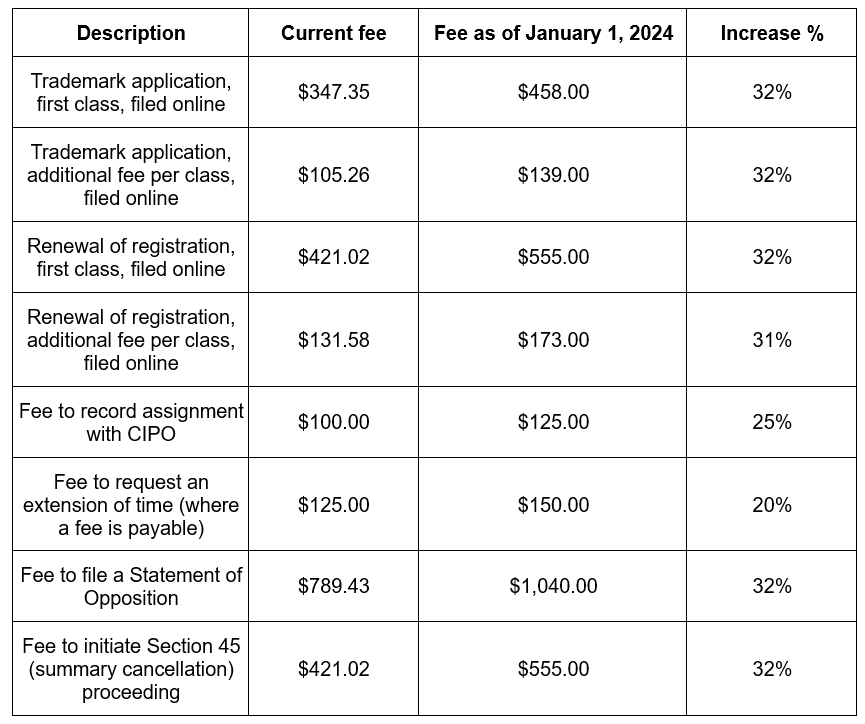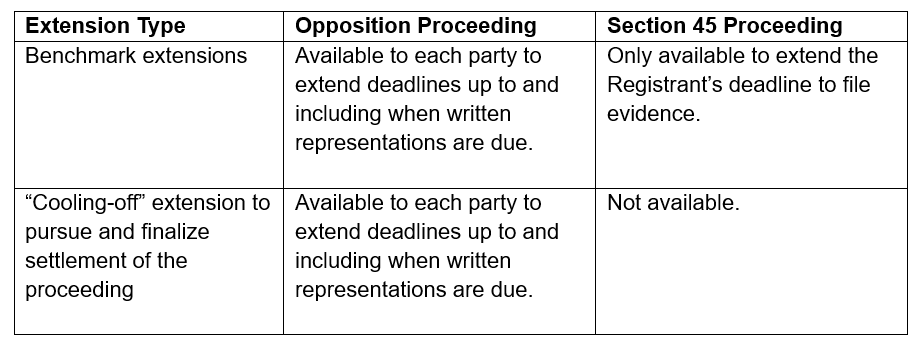2023 was an active year in Canadian trademark law. Canadian Courts addressed a wide range of issues, from licensing to comparative advertising to co-branding.
Notable changes also emerged from the Canadian Trademarks Office. Extensions of time available in Oppositions and section 45 (non-use cancellation) proceedings were significantly reduced. Additionally, many trademark fees increased by 20-35%. The Trademarks Office also launched a new online Trademark Document Retrieval Service, which improved access to correspondence filed at the Office.
This article highlights some important decisions from 2023 and looks back at key developments in Canadian trademark practice.
Table of contents
Notable Canadian trademark cases
- Can a retailer register its trademark in association with goods which it sells and brands with its trademark, but does not manufacture?
- Revisiting the issue of confusion between foreign-language character trademarks, and a claim of bad faith
- A reminder that evidence matters in trademark disputes
- On the importance of properly managing trademark licenses
- Useful guidance for brand owners on comparative advertising
- A cautionary tale about co-existence agreements and trademark consent documents
Practice updates
- Increases to CIPO’s official fees
- Reduction in extensions of time available in Oppositions and Section 45 proceedings
- Launch of TDRS & Electronic Correspondence
Notable Canadian trademark cases
1. Can a retailer register its trademark in association with goods which it sells and brands with its trademark, but does not manufacture?
It is not uncommon for retailers to display their trademark on the products they sell, even if those products are manufactured by third parties and prominently display their respective brands. This practice, however, raises an interesting question in trademark law: does it enable the seller to register its trademark in connection with the products it sells? One of the Federal Court’s first decisions in 2023, GNR Travel Centre Ltd v CWI Inc, 2023 FC 2, offers some guidance.
GNR, a retailer of RVs, sought to register the mark GNR CAMPING WORLD & Design (the “Trademark”) in association with recreational vehicles and the retail sales of such vehicles. Another major RV retailer, CWI, opposed the application, arguing that GNR had not used the Trademark in Canada with each of the goods and services listed in the Application as of the claimed dates of first use.
The Opposition Board found that GNR established that it had used the Trademark in association with the goods, but not in association with the services. On appeal, the Federal Court affirmed the Board’s finding.
With respect to the goods, the Court found that while GNR is not the manufacturer, the presence of stickers with the Trademark affixed to the goods before sale was deemed sufficient to establish trademark use in association with the goods. The Court rejected the notion that only an original manufacturer of a good can claim to use a trademark with those goods, while all others in the supply chain, such as retailers, are merely providing a service, such that any trademark they affix to the goods becomes associated only with their service.
Ironically, GNR failed to provide enough evidence to establish that it had used the Trademark in association with their services as of the claimed date. In that regard, the Court noted that a mere attestation in an affidavit is insufficient. Considering that the services could be expected to be provided online, the Court also upheld the Opposition Board's reliance on archived webpages, which revealed no use of GNR's trademark at the claimed date.
This decision is currently under appeal.
2. Revisiting the issue of confusion between foreign-language character trademarks, and a claim of bad faith
In the latest episode of a longstanding dispute between two bakeries, the Federal Court revisited the issue of confusion between foreign-language character trademarks and considered a claim of bad faith.
Cheung’s Bakery Products Ltd. (CBP), the Applicant in the case before the Federal Court, has operated an award-winning bakery in the Greater Vancouver Area for nearly 50 years, offering bakery-related products and services in association with one or more of the following trademarks featuring Chinese characters:

(collectively the Cheung Marks)
The Respondent Easywin Ltd (Easywin) is part of the Saint Honore Group of companies (Saint Honore), which operates one of the largest chains of bakery stores in Hong Kong and also makes and sells bakery-related food products for distribution in various markets, including in Canada.
In the late 2000s and early 2010s, CBP and Saint Honore were previously involved in a dispute relating to some of the above-noted Chinese characters, with CBP being successful before the Opposition Board, Federal Court, and Federal Court of Appeal.
However, in July 2019, and unbeknownst to CBP, Easywin obtained registrations for two marks, both of which comprised the two Chinese characters 安娜 that are found in each of the Cheung Marks translating into English as “Anna” or “Anna’s” and transliterating to “an na” (in Mandarin) or “on naa” (in Cantonese).

(collectively, the“Easywin Marks)
CBP brought an application against Easywin in the Federal Court, seeking to expunge the Easywin Marks on the grounds of trademark confusion and bad faith.
On the issue of confusion, the Court inferred from the evidence that the likely (and targeted) consumers of the parties’ goods and services, namely the Chinese Canadian community, would be able to read and understand Chinese characters. Therefore, rather than interpreting the parties’ Chinese character marks simply as design elements, the relevant consumer would understand their meaning. Given that each of the parties’ marks shared the same two Chinese characters as dominant elements, the Court found that the parties’ trademarks were similar in appearance, sound, and ideas suggested. This was the same conclusion reached by the Opposition Board, Federal Court, and Federal Court of Appeal in the previous dispute between CBP and Saint Honore.
The Court also held that the applications for the Easywin Marks were filed in bad faith. At the time of filing, Easywin was clearly aware of the previous dispute between its sister company and CBP, but it nevertheless proceeded to file and register the Easywin Marks in Canada. Overall, the Court determined that Easywin could not have been satisfied that it was entitled to register the Easywin Marks.
Read the full article about this decision.
3. A reminder that evidence matters in trademark disputes
Parties to trademark opposition proceedings are often encouraged by their counsel to submit evidence showing use of their trademarks. This process requires time, effort and comes with a significant cost. Does it actually pay off? The answer is yes, and the saga of Puma v Caterpillar, 2023 FCA 4 shows why. Puma SE was the applicant for the trademark PROCAT for use with footwear and headwear. Caterpillar Inc opposed Puma’s application, arguing PROCAT would be confusing with its own marks “CAT & Triangle Design” (below) and the word CAT for similar goods.

At first instance, Puma won. The Trademarks Opposition Board found there was only “some resemblance” between PROCAT and CAT, and so allowed Puma’s application. However, this outcome changed when new and weighty evidence was filed by Caterpillar at the Federal Court on appeal.
Notably, Caterpillar filed evidence which tended to reduce the trademark significance of the prefix “PRO” in PROCAT, with dictionary entries showing “pro” means “professional” – a laudatory term with limited inherent distinctiveness. While Puma attempted to resist this shift in the case with evidence that its PROCAT mark was known to consumers and therefore possessed significant acquired distinctiveness, that evidence did not stand up to scrutiny. Specifically, Puma’s sales were in association with “water bottles, hairbands, soccer balls and shin guards,” and not the goods in question. The Court therefore treated CAT as the dominant feature of PROCAT, turning the opposition into a true CAT fight.
In contrast to the weak evidence from Puma, Caterpillar’s evidence showed years of significant use of its CAT trademarks, convincing the Court its trademark had “earned the protection provided for by the Act through use” (in the words of the FCA). While Puma claimed it too had a history with CAT-formative marks, its marks were mere sub-brands, used in small font sizes, and always with the company’s more famous “Jumping Cat” logo. The Court therefore doubted consumers would associate CAT trademarks with Puma, and on the questions regarding “extent” and “length” of use, sided with Caterpillar. In the result, the Board’s decision was overturned, and Puma’s application was refused.
When Puma brought the case to the Federal Court of Appeal, there was little left to argue. Upholding the lower Court’s decision, it wrote: “Ultimately, the Judge’s decision in this case was predominantly based on the lack of evidence that [PROCAT] had ever been used in Canada to the extent that it would have acquired distinctiveness or become known.”
This case serves as a reminder that evidence matters in trademark disputes, including opposition matters. With Caterpillar benefitting from a stronger record of consumer recognition, Puma could not meet its burden to show PROCAT would not be likely to confuse consumers. With leave to appeal to the Supreme Court of Canada refused, its application was denied.
4. On the importance of properly managing trademark licenses
In an appeal of a decision reported in our 2022 Trademarks Year In Review, the Federal Court of Appeal had occasion to remind trademark owners of the importance of properly managing trademark licenses.
The plaintiff in this case, Milano Pizza, was the owner of the registered trademark MILANO PIZZERIA & Design, which it licensed to a number of independently owned pizzerias in Canada: 
When one former licensee continued to use the MILANO PIZZERIA & Design trademark and other MILANO-formative marks after the expiration of an agreement between them, Milano Pizza brought an action for trademark infringement, passing off, and depreciation of goodwill.
The Defendants brought a counterclaim for expungement of the Milano Design Mark by reason of non-distinctiveness, abandonment, and non-entitlement. The Federal Court found that the Milano Design Mark was not distinctive and therefore invalid, concluding that the Plaintiff was unable to demonstrate sufficient control over the goods and services provided by the licensees.
The central issue under appeal concerned whether the Federal Court incorrectly applied the legal test for assessing control over licensees, as per subsection 50(1) of the Trademarks Act. Specifically, Milano Pizza argued that courts should not interpret a licensor's control and should accept a trademark owner's claim of asserting control.
The Federal Court of Appeal disagreed, noting that the Federal Court determined the complete absence of control without imposing how a trademark owner needed to exercise control. Nevertheless, the court specified that “it would make a mockery of section 50(1) if any type or degree of control was acceptable” (para 6).
This decision highlights the significance of a licensor’s responsibility to exercise a sufficient degree of control over not only the trademark itself, but also the quality of the finished products or services offered by licensees.
For a more comprehensive summary of this decision and a review of the best practices that trademark owners should consider when licensing their trademarks in Canada, we invite you to read our full articles: Federal Court of Appeal confirms the importance of a licensor’s control over finished products and services and How to slice through trademark challenges: Key takeaways for proper trademark licensing.
5. Useful guidance for brand owners on comparative advertising
In its much-anticipated decision in Energizer Brands, LLC v Gillette Company, 2023 FC 804, the Federal Court provided a timely review of the law on “comparative advertising” and the prohibition of “depreciation of goodwill” under section 22 of the Trademarks Act.
The case centred around Duracell’s use of Energizer’s registered trademarks ENERGIZER and ENERGIZER MAX, as well as its use of the expressions "the bunny brand" and "the next leading competitive brand", which were featured on packaging labels or stickers as part of Duracell’s comparative advertising campaign.

The Court ruled that Duracell’s use of Energizer’s registered trademarks ENERGIZER and ENERGIZER MAX contravened section 22 and awarded a permanent injunction and damages in favour of Energizer. The Court, however, dismissed the remainder of Energizer’s action, notably with respect to the use of the expressions "the bunny brand" and "the next leading competitive brand".
In reaching this conclusion, the Court gave particular emphasis to the context, placement, and size of the mark in relation to other surrounding indicia, thus providing useful guidance to brand owners engaging in comparative advertising and incorporating references to other brand owners in their marketing campaigns.
For a more comprehensive summary of this decision, we invite you to read our article: Federal Court’s decision in Energizer Brands, LLC v Gillette Company narrows test for depreciation of goodwill in comparative advertising cases.
6. A cautionary tale about co-existence agreements and trademark consent documents
When a business adopts a trademark similar to one owned by somebody else big problems can arise. But not always. What may appear concerning to outsiders may not pose a practical problem for either business. In such situations, parties often agree contractually to “co-exist.”
So, what happens when the Trademarks Office objects that an applied-for trademark is confusing but the owner of the allegedly-confusing trademark does not find it objectionable? The case of Tweak-D Inc v Canada (2023 FCA 238) is a reminder that what goes into a co-existence agreement is paramount – unlike other countries, filing a mere consent from the “confusing” mark’s owner is unlikely to get the objection from the Trademarks Office withdrawn.
The protagonist of this story is Tweak-D Inc, a Canadian company with the trademark TRIBAL CHOCOLATE. According to paperwork filed with the Trademarks Office, it introduced this mark to Canada in 2016, and in 2017 filed an application to register it with – among other things – hair dyes.
An application to register a trademark “must be refused if it is confusing with another already on the register,” says the Trademarks Act. Standing in Tweak-D’s way was a third-party registration for TRIBAL, also for hair dyes, dating back to 2012. The Trademarks Office duly raised an objection.
Tweak-D fought the objection in several ways. For one, it noted that TRIBAL already co-existed on the register with TRIBAL INDULGENCES, TRIBE, and URBAN:TRIBE. Hence, in its view, the mark TRIBAL was being given too broad a monopoly.
Additionally, Tweak-D filed a document signed by the owner of TRIBAL, wherein the owner agreed that its mark is not confusing. This agreement also put in place certain safeguards meant to guard against actual confusion, such as:
- Tweak-D would sell its goods to mass-market retailers, drugstores, home shopping channels or internet retailers, but not beauty salons and spas.
- Neither party would change the depiction of their respective trademarks to increase their similarity with the branding or form previously adopted by the other party.
- Neither party would promote its goods in a manner which could cause confusion or indicate that there may be an association with the other party.
Surely “the foregoing is satisfactory,” Tweak-D wrote to the Trademarks Office. It was not. The Registrar maintained its objection and refused the TRIBAL CHOCOLATE application.
An appeal followed, and then a second. None would change the outcome.
Despite the existence of a co-existence agreement between the parties, the Trademarks Office was not satisfied that the marks were not confusing. In its view, the agreement provided “only contractual protection between the parties.” The Court of Appeal did not disagree.
This case serves as a reminder that while it is theoretically possible to overcome confusion objections with consent agreements, the practical reality is that such an approach is far more likely to fail than succeed. And, in the rare cases where success occurs, it is the content of the agreement that carries weight. The agreement in Tweak-D did not contain enough information to explain to the Trademarks Office, or the courts, why confusion was unlikely.
A co-existence agreement can be a powerful tool – but as this case shows, only if smartly drafted. Additionally, a party to such an agreement must accept the risk that the Canadian Trademarks Office will refuse to register their trademark, even with the consent of the other party.
Practice updates
1. Increases to CIPO’s official fees
In 2023, CIPO announced significant increases to its official fees, which took effect as of January 1, 2024.
As previously reported, some of the most commonly paid Canadian trademark fees increased
by 20-32%, as shown in the table below. 
According to CIPO, the fee increases were necessary to, among other things, return it to a position of financial sustainability following the convergence of various operational and financial factors that put the organization in a critical financial position. These factors include labour costs, application volumes, and inflation since the last time CIPO’s official fees underwent a full review and substantial adjustment in 2004. Notably, CIPO relies entirely on the revenue generated from official fees to fund its operations. It does not receive any annual operational funding from the Government of Canada.
It is also believed that the fee increases will go, at least in part, toward the hiring and training of new trademark examiners. CIPO previously shared that over 100 new examiners were hired in 2023. Once the new examiners have completed their onboarding and training, the current delays in Canadian trademark examination will hopefully be reduced.
2. Reduction in extensions of time available in Oppositions and Section 45 proceedings
During the course of Oppositions and Section 45 (non-use cancellation) proceedings, parties can request various extensions of time, including the following:

CIPO announced in late 2023 that extensions of time available in Oppositions and Section 45 (non-use cancellation) proceedings would be significantly reduced as of December 1, 2023. The reductions to time extensions range from 20% to 75% at different stages of the proceedings and the changes vary for Oppositions and Section 45 proceedings.
With respect to Section 45 proceedings, brand owners should be aware that the benchmark extension of time available to file evidence has been reduced from four months to two months (i.e. a 50% reduction).
As for Oppositions, the benchmark and cooling-off extensions available to the parties have been significantly shortened. For example, the benchmark extension available to file the Statement of Opposition has been shortened by 50% from four-months to two-months as of December 1, 2023. Additionally, the “cooling-off” extension available to each party (on consent) has been reduced from nine months to seven months.
Read the full article for a more exhaustive list of the changes to time extensions available at all stages of Opposition proceedings.
3. Launch of TDRS & Electronic Correspondence
CIPO announced two new technological advancements in 2023.
The first is an online platform known as the Trademark Document Retrieval Service ("TDRS"). This service allows the general public to retrieve electronic copies of documents issued by and submitted to CIPO in respect of Canadian trademark applications and registrations. Such documents include those filed during the course of examination, Oppositions, and Section 45 proceedings. Before the introduction of the TDRS, obtaining documents related to an application or registration required requesting paper copies from CIPO.
The second is the ability for trademark agents, brand owners, and parties in Oppositions and Section 45 proceedings to communicate with CIPO electronically. Notably, those wishing to take advantage of electronic correspondence must opt in and select email as their preferred method to receive correspondence. If no action is taken, CIPO will send correspondence through mail by default.
Stay tuned
Stay up to date on IP law developments in Canada in 2024 through our IP Updates and Rx IP Updates. Subscribe now to receive these in your inbox throughout the year.
If you have any questions or require further information on the notable developments and decisions discussed in this article, please reach out to the authors or any member of our Trademarks & Brand Protection team.
The preceding is intended as a timely update on Canadian intellectual property and technology law. The content is informational only and does not constitute legal or professional advice. To obtain such advice, please communicate with our offices directly.
Related Publications & Articles
-
In(dustry) focus: consumer goods – a complete IP framework for entering the Canadian market
In this first article of the series, we explore consumer goods. Given the upcoming holiday season, we will use a fictional toy – “Andy the Ampersand” – to convey our insights. Whether you’re new to th...Read More -
Double patenting and divisionals in Canada: evolving strategies for applicants
Double patenting and unity of invention in divisional practice remain central issues in patent prosecution in different jurisdictions, but the strategies for addressing them differ sharply between Can...Read More -
Canadian patent law 2025: a year in review
2025 saw a significant statutory change and the long-awaited Supreme Court of Canada hearing of an appeal regarding the patentability of methods of medical treatment. The courts also considered due ca...Read More
